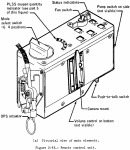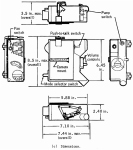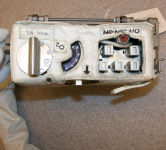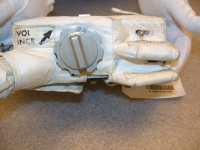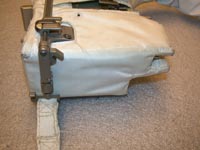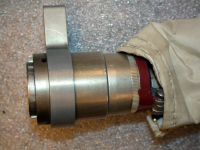
Apollo Remote Control Unit (RCU)
for the Portable Life Support System (PLSS)
and Extravehicular Mobility Unit (EMU)
Copyright 2006 by Karl Dodenhoff.
All rights reserved.
Last revised 1 August 2009.
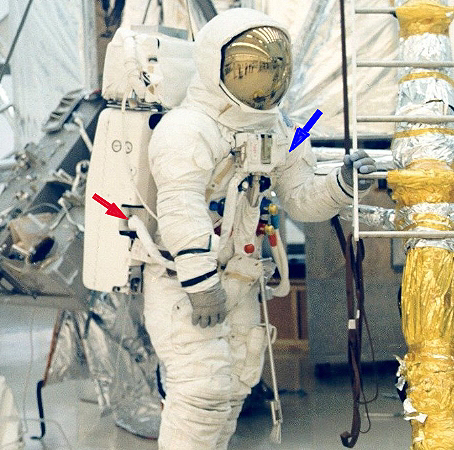
(Above) Apollo 13 astronaut James Lovell during EVA training.
The blue arrow points to the RCU. The red arrow points to where
the RCU umbilical connected to the PLSS.
Detail from NASA photo AP13-KSC-70PC-12
The RCU was a component of the total Extravehicular Mobility Unit
(EMU) space suit system, which also included the Portable Life
Support System (PLSS), Oxygen Purge System (OPS), and the suit
itself. The system was added to the EMU after the redesign
following the Apollo 1 accident.
Mounted on the chest of the EMU, the system provided simple
controls for communications and some EMU functions, as well as
warnings and indicators for EMU status. It had a secondary
function as a mounting for the standard Apollo Hasselblad camera
and Oxygen Purge System actuator.

(Above) The first operational EMU test.
Apollo 9 astronaut Rusty Schweickart on the porch of LM-3
"Spider".
Note that this early RCU didn't have the warning indicators,
nor the Hasselblad camera mount.
Detail from NASA photo AS9-19-2994
 |
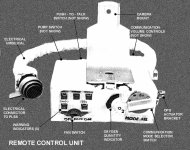 |
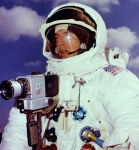 |
Oxygen Quantity
Indicator Legend
Ref. 4
|
Major Features
Ref. 5
|
James Lovell
during EVA training
with Hasselblad
mounted on the RCU
Ref. 6
|
Looking at the top of the RCU (from the rear, as the crewmen
did when it was mounted on the EMU), the features are as follows,
from left to right:
- The suit fan switch
- Status Indicators (called "flags") for Oxygen, etc.
- Oxygen Quantity Indicator
- Communications (Radio) Mode Selector
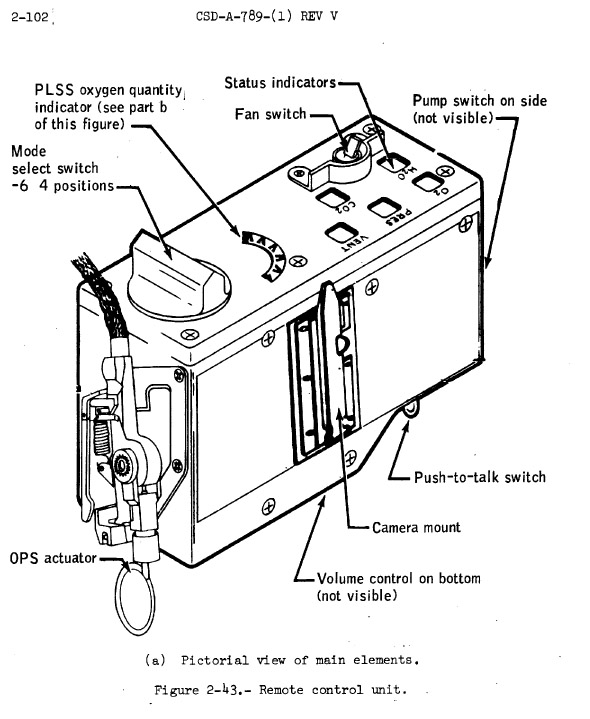
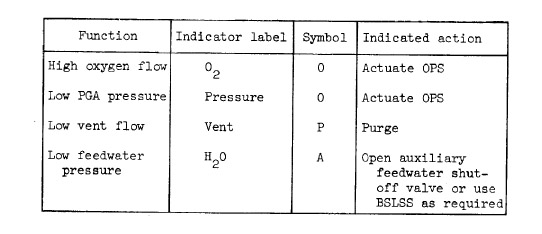
Status Indicators (Warning
Flags): Any one of four problems (high
oxygen flow, low vent flow, low PGA pressure, or low
feedwater
pressure) will cause a cylinder to rotate and reveal
the illuminated warning symbol underneath.
|
On the bottom of the unit are located controls for radio
volume, the suit water pump, and a radio push-to-talk switch. The
electrical umbilical which connected the RCU to the PLSS was also
located here.
On the right side of the unit (again looking from the rear) was
mounted the OPS actuator, used to supply emergency oxygen in
case of a suit failure
The left side was featureless, except for a bar and strap
used to operate the clamps that attached the unit to the EMU.
On the front face of the unit, (as seen standing in front
of the crewman) was the Hasselblad camera mount, and the crewman's
name tag (in red for the Commander, and in black for the Lunar
Module Pilot).
On the rear face was a set of clamps used to attach the
RCU to the suit. Two upper clamps attached to the PLSS
shoulder straps, and a 3rd one attached to a bracket on the fornt
of the EMU. A small strap was included to operate the clamps
with the bulky lunar gloves on.
Photos by Ulli Lotzmann
Used with permission.
This is a training unit, now in the Smithsonian Institution's
Garber Facility
where Ulli photographed it in 2006 with the invaluable aid of
Amanda Young.
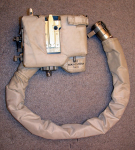 |
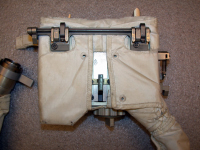 |
Beautiful photo of
the overall system
( High-Res link )
|
Rear face, showing clamps
used to attach the unit
to the EMU
( High-Res link )
|
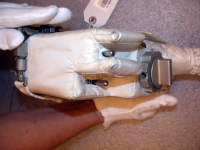 |
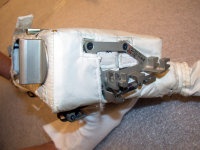 |
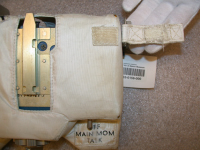 |
|
|
Right side - OPS Actuator
bracket.
( High-Res link )
|
Front face - the strap used
to work the clamps which
attached the unit to the EMU
( High-Res link )
|
Photos by Paul Kashuk
Used with permission.
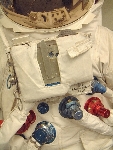 |
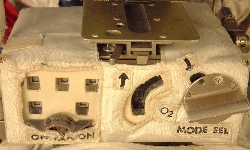 |
Front face. Note
OPS actuator pull
ring at left
|
Top view
|
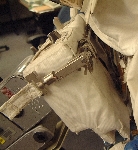 |
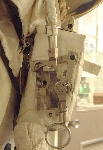 |
Left side. Note strap
used to operate clamps
that attched unit to
the EMU
|
Right side - Note
OPS actuator
bracket & pull ring.
|
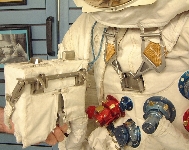
Above: The 3 clamps that attached the unit to the suit
are clearly visible here, as well as the parts of the suit they
attached
to. The top 2 clamps attached to the horizontal bars on
the PLSS shoulder straps, seen just below the helmet
cowling. The bottom clamp attached to the bracket onto
which the PLSS shoulder straps are attached, seen just above the
small blue circular fitting at the center of the chest
References
1. Portion of Figure 2-43a, Section 2.5.7 in "Apollo Operations
Handbook, Extravehicular Mobility Unit, Vol. 1, System Description,
CSD-A-789-(1), Apollo 15-17 Rev. V, March 1971."
2. Portion of Figure 2-43c, Section
2.5.7 in "Apollo Operations Handbook, Extravehicular
Mobility Unit, Vol. 1, System Description, CSD-A-789-(1), Apollo
15-17 Rev. V, March 1971."
3. Figure 2.11.5, page 2.11-8 in "Apollo
Operations Handbook, Lunar Module, LM-10 and Subsequent, Vol. 1,
Systems Data, NAS 9-1100, 1 April 1971."
4. A portion of Figure 2-43b, Section
2.5.7 in
"Apollo Operations Handbook, Extravehicular Mobility Unit, Vol. 1,
System Description, CSD-A-789-(1), Apollo 15-17 Rev. V, March
1971."
5. This is believed to be a Hamilton-Standard
illustration.
6. NASA Photo 70-HC-74.
Journal Home Page



